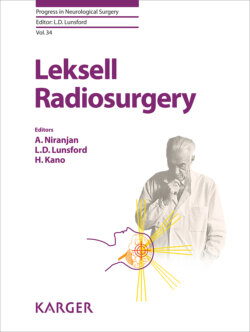Читать книгу Leksell Radiosurgery - Группа авторов - Страница 28
На сайте Литреса книга снята с продажи.
Creation of the Team and the First Patients
ОглавлениеDespite the history of the Gamma Knife as a surgical tool used by neurosurgeons with the assistance of medical physicists, this required tweaking in the USA. I submitted my credentials, including experience with intracavitary radiation, to our Radiation Safety office. They in turn received approval from Region 1 of the NRC to name Lunsford as an authorized user. We knew that we needed the expertise of medical physics as well as radiation oncology. The program at Pitt was blessed with the hiring of John Flickinger, a radiation oncologist trained at the Harvard system, as well as the support of Melvin Deutsch. Most of the published knowledge related to the use of Gamma Knife reflected its role in deep-seated arteriovenous malformations and some experience in acoustic neuroma. Our colleagues in neurosurgery over the years had collected a group of deep-seated arteriovenous malformation patients, some of whom had been partially embolized, who were waiting for the opening of the Gamma Knife program. These patients reflected our initial experience, beginning with the first case on August 14, 1987.
The initial cases began in conjunction with visits by Danny Leksell and Ladislau Steiner during our first 6 months of operation. We hired one operating room nurse to manage the patient care, soon realizing that our patients needed supplemental conscious sedation to make the frame application experience very tolerable. The first arteriovenous malformation cases were performed with biplane angiography after frame application and the first acoustic cases with CT scanning. Imaging acquisition at that time was somewhat tedious, making sure that patients were properly leveled and that the fiducials on the frame adapters could be seen. There was no image integration. We used the KULA dose planning system. Calculation of a single isocenter (Shot) took 6 min in an inexact mode. Two shots took 12 min, etc. The shots were printed out on clear plastic at the magnification of the CT or angiogram films, and matched to the central beam location. If you were not satisfied with this initial iteration, recalculation was required, at another 6 min per shot. The new plan was reprinted and overlaid on the images [12, 13]. The longest dose planning time was 240 min. Actual treatment in the original U unit was almost an anticlimax, as the 201-source unit had been recently loaded so the dose rate was >300 cGY per minute. Each shot required setting up the coordinate in x, y, z planes on the stereotactic frame. Three people (a radiation oncologist, neurosurgeon, and medical physicist) verified that the coordinates were correct before leaving the room to deliver the radiation to that isocenter based on the time per shot. Different collimator helmets were used and required the use of a hydraulic forklift to hoist the 250 kg helmets. We never dropped one, but that did happen elsewhere.
In 1991 the first MRI center was developed in a separate building 1 mile from the hospital (another attempt at restricting proliferation of “yet to be proven” technologies). We began to put frames on in the Gamma unit under mild sedation, and then transporting the patient to the NMR Center by ambulance. Again, we had to make hard copy images and bring them back to our center for the dose planning. The first MRI center on site at Presbyterian Hospital was established in 1993, a 0.5-T unit with a coil big enough to include the frame. Transportation became much easier.
It became clear that image integration with newly emerging faster computers was the future. Grace Yum began to develop an image integrated system in collaboration with medical physics director Andre Kalend using a Silicon Graphics computer into which we could load the digital images. The first Elekta image-integrated dose planning system was delivered within the next 2 years (Leksell GammaPlan 1.0). Although our initial indication was vascular malformations and skull base tumors, by 1991 interest had developed in treating solitary brain metastases [14]. Quality assurance of Gamma Knife became an integral part of the procedure as 1 day in a week was dedicated for this purpose [15].
